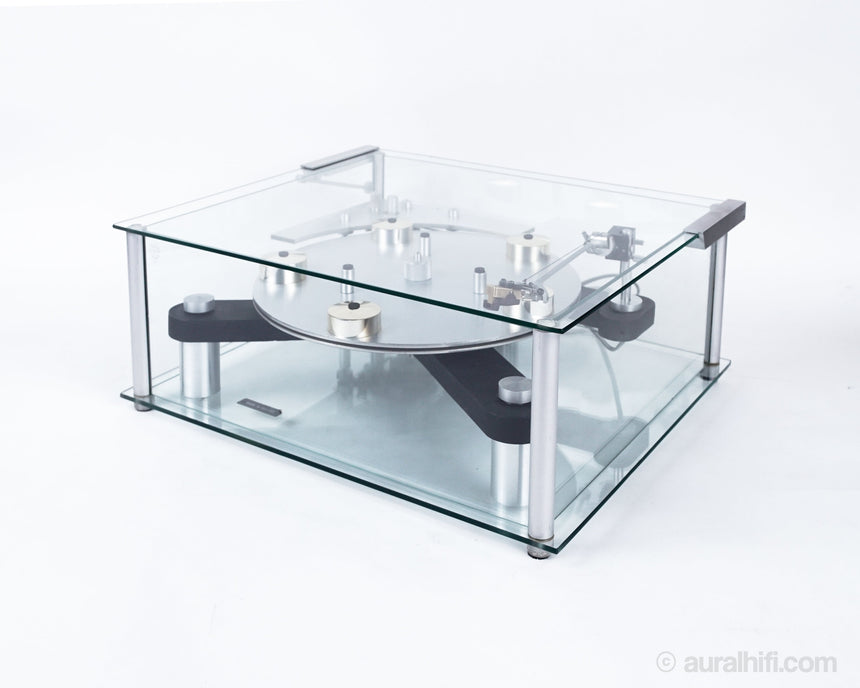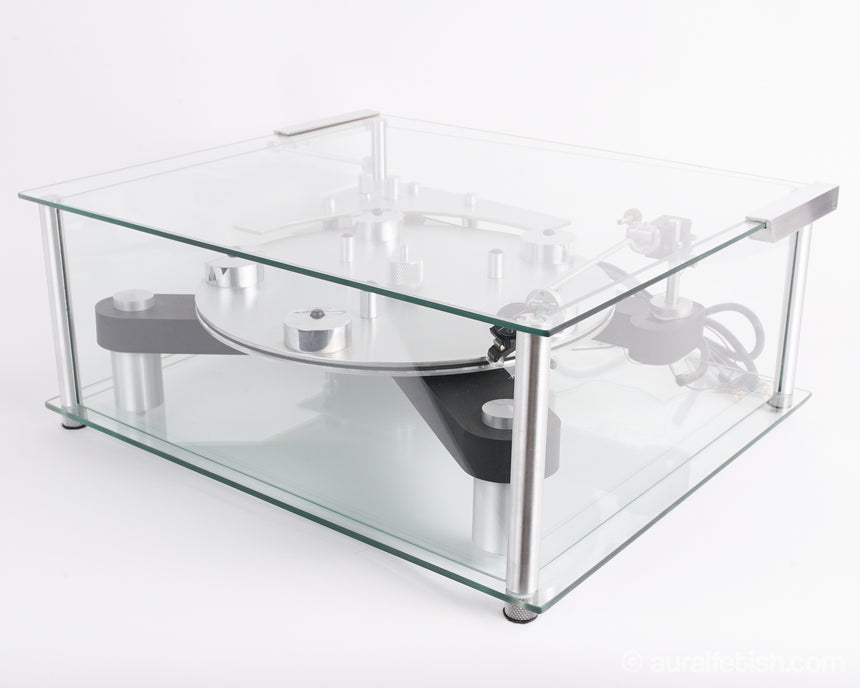The History of Transcriptors

Transcriptors was founded in 1960 by the late David Gammon along with his brother Anthony as secretary, which was a legal requirement at the time. The company was one of the World’s leading manufacturer of manual turntables, tone arms and accessories, and one of the most modern hi-fi manufacturing plants in Europe during the 60’s, 70’s and the early 80’s. Transcriptors turntables have been widely used in numerous television commercials, and in many films, including the classic A Clockwork Orange (1972) and The Look Of Love (2013) both that featured Gammon's classic 1964 hydraulic reference turntable. The Skeleton turntable was also used in the X-Men – First Class (2011) and Creepshow (1982)
Gammon was employed by Almer Components as chief engineer when he designed the Transcriptor arm along with the sweep arm and stylus brush. These designs were born due to the lack of professional devices that were manufactured by various audio companies. His friend Brian Allan (who was an architect) suggested to David that they should take some photographs and send them to Hi-fi News as a joke not thinking they would get published. He was amazed to find in their next issue that the pictures had been published. David started producing the Transcriptor Arm and the accessories part-time in his flat. It was not until he was approached by an audio research laboratory in the early months of 1963, that he started production of the Reference turntable. The laboratory required a turntable that could meet the strict criteria required for highly accurate audio testing, and so the Reference turntable was designed. It was designed around the Transcriptor arm and was the most advanced turntable unit that had been produce at that time. He also designed a turntable unit for the then British audio company, Goodman’s.
In 1964 after leaving Almer Components, they offered him two rooms for thirty pounds a week at Holloway Road, which were situated above the Almer Components premises, and with a small workforce of seven he started production on a full-time basis. However after a year, he outgrew the premises, and moved to Theobald Street, Borehamwood.
After moving to the new factory he was now in the position to increase turntable production. A year later this resulted in his next design, the Saturn. The table was produced alongside the Hydraulic turntable. In 1969 the late Stanley Kubrick visited David at his Borehamwood factory and asked him if he could purchase a Hydraulic Reference to use in his latest film project. He let Stanley have the turntable. The turntable made its appearance in the bedroom and hospital scene of the 1971 classic, A Clockwork Orange which starred the much acclaimed actor Malcolm McDowell. Various turntable parts were also used in another Stanley Kubrick production, 2001 A Space Odyssey. Other designs included display turntables for various department stores.
In 1971, David received an invitation from the London Design Centre, to collect a design award for the Hydraulic Reference turntable. He received his award from the late HRH Princess Margaret at a lavish presentation evening. David was also present at many social events, which included hi-fi shows all over the world, even parties hosted by the Queen. Some of the last Hydraulic Reference turntables carry the design award logo which is located bottom left on the acrylic lid. He also received many other awards from all over the world, Japan and the former state of Yugoslavia.
Towards the end of 1973 the Irish government offered a purpose-built factory which was ten times the size of the Borehamwood factory, and could manufacture all components in-house without the need to subcontact work to other companies. This combination would also allow him to take turntable design even further.
Relocating to Carlow Ireland. David sent his chief engineer Keith Weightmen to set up the factory in Ireland ready to carry on production of the Saturn until the middle of 1973. Due mainly to the oil shortage and the large cost of using acrylic as a material to manufacture turntables, he turned to glass. He drew a glass case and took it to the windscreen manufacture Triplex, and asked if it was possible to manufacture. They took a look a the design and said “no problem”. He had previously woke up in the early hours of the morning and said “Yes!, I’ve done it”. In eagerness to get his idea on paper, he sketched his idea on to the back of a Benson’s & Hedges cigarette packet. The turntable was the Skeleton and featured the famous, but controversial, Vestigal tonearm, with it’s unique head shell design. Nobody could exactly understand how it worked but worked it did.
Instead of the conventional tone arm design, where the arm is pivoted at the rear, balanced by an extremely heavy counterbalance, the Vestigal tonearm was pivoted at the head shell allowing for a very small counterbalance and tracking force. In 1974, David moved his family to New York. Here he opened an office to satisfy the American market. No sooner than he got arrived, that he was overcome by orders for the Skeleton and also the Vestigal tonearm which was also sold as a separate.
As usual, hi-fi press, as well as the general public, were complaining about the scaling prices of hi-fi components. To answer this call, he took all the main components of the more expensive Skeleton, scaled it down and produced the Round Table. It featured a tone arm fitted to the lid, which allowed easy changing of the record. The turntable sold for twenty-five pounds.
As with all Transcriptors products, it was well thought out and well-engineered turntable. Keep in mind, like all the other Transcriptor turntables, it used jewel pivots in its tone arm construction. However, for some strange reason, none of the complaining public bought the turntable, so only 300 were produced, and production lasted only for a year, which makes this particular turntable very rare and collectible.
In the sixties and early seventies, J A Michell Engineering ran a small engineering business next to Transcriptors carrying out various contracts including work for the film industry. In the early days of Transcriptors, David contracted work to various engineering companies including Michell as he had no machine shop at the Borehamwood factory.
In 1973 when Transcriptors relocated to Carlow in Ireland, David and John signed a contract which was known as the ‘Technical Agreement’ which allowed Michell to reproduce the Hydraulic Reference turntable under license. This was the first branded Michell turntable and was manufactured until November 1977 when David revoked the license.
David’s design concept was inspired by old clocks and watches from the 17th and 18th century. David had often asked this question many times over, why put something of engineering elegance into a black case or even worst, into a wooden case, that looked as if it had been made down in somebody’s garden shed. In fact Transcriptors started the trend to expose all the components so that they could be viewed from all angles. Manufactured from aluminium and acrylic to very high tolerances, tested, the end result always being a highly polished, highly accurate turntable. Designed and built with the skill of an 18th century clock maker. It is somewhat ironic, then, that such a timeless design was inspired by watchmaking.
The turntables have appeared in many films and TV commercials including the Kellogg’s cereal advertisement through to the Heartbeat TV series. They have also been reproduced not necessary legally, in one form or the other by companies from all over the world such as the Michell/Simon York Designs/Audio Linear even Concept 2000 and Sykes & Hirsch, used the fluid arm on their Compacta.
Many famous people have had or still have a turntable. These celebrities have included the band members of super group Pink Floyd, Paul Raymond, Elton John, Peter Noon of Herman’s Hermits, Royalty and also the late legendary record producer Mickey Most. The turntables have also been given as gifts to numerous museums such as the American Museum Of Modern Art New York, The Design Museum London, Pinakother Der Modern Munchen, Germany and even Japanese Museums.
Manufacturing Facilities/Offices
- Bloombury Way, London, England (1960)
- West Hampstead, London, England (1960 – 1966)
- 511 Holloway Road, N19, Archway 6419, London, England (1966 – 1967)
- 2 Theobald Street, Borehamwood, Hertfordshire, England (1967 – 1973)
- Carlow Industrial Estate, Carlow, Ireland (1973 – 1981)
- 350th West 58th Street, New York, 10019 USA (1974 – 1975)
- 509 5th Avenue, New York, 10017 (1974 – 1975)



